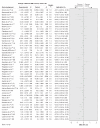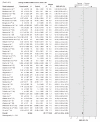Prevention of overweight and obesity in children and youth: a systematic review and meta-analysis
- PMID: 25844367
- PMCID: PMC4382039
- DOI: 10.9778/cmajo.20140053
Prevention of overweight and obesity in children and youth: a systematic review and meta-analysis
Abstract
Background: One-third of Canadian children are overweight or obese. This problem carries considerable concern for negative impacts on current and future health. Promoting healthy growth and development is critical. This review synthesized evidence on the effectiveness of behavioural interventions for preventing overweight and obesity in children and adolescents.
Methods: We updated the search of a previous Cochrane review. Five databases were searched up to August 2013. Randomized trials of primary care-relevant behavioural (diet, exercise and lifestyle) interventions for preventing overweight and obesity in healthy normal- or mixed-weight children or youth aged 0-18 years were included if 12-week postbaseline data were provided for body mass index (BMI), BMI z-score, or prevalence of overweight or obesity. Any study reporting harms was included. Meta-analyses were performed if possible. Features of interventions showing significant benefits were examined.
Results: Ninety studies were included, all with mixed-weight populations. Compared with controls, interventions showed a small but significant effect on BMI and BMI z-score (standardized mean difference -0.07, 95% confidence interval [CI] -0.10 to -0.03, I (2) = 74%), a reduction in BMI (mean difference -0.09 kg/m(2), 95% CI -0.16 to -0.03, I (2) = 76%) and a reduced prevalence of overweight and obesity (risk ratio [RR]; RRintervention - RRcontrol 0.94, 95% CI 0.89 to 0.99, I (2) = 0%; number needed to treat 51, 95% CI 29 to 289). Little evidence was available on harms. There was variability across efficacious interventions, although many of the interventions were short-term, involved school-aged children and were delivered in educational settings.
Interpretation: Behavioural prevention interventions are associated with small improvements in weight outcomes in mixed-weight populations of children and adolescents. No intervention strategy consistently produced benefits.
Registration: PROSPERO no. CRD42012002754.
Keywords: This article has been peer reviewed..
Conflict of interest statement
Figures





References
-
- Eckersley RM. Losing the battle of the bulge: causes and consequences of increasing obesity. Med J Aust 2001;174:590-2. - PubMed
-
- Mokdad AH, Ford ES, Bowman BA, et al. Prevalence of obesity, diabetes, and obesity-related health risk factors, 2001. JAMA 2003;289:76-9. - PubMed
-
- Flegal KM, Graubard BI, Williamson DF, et al. Excess deaths associated with underweight, overweight, and obesity. JAMA 2005;293:1861-7. - PubMed
-
- Allison DB, Fontaine KR, Manson JE, et al. Annual deaths attributable to obesity in the United States. JAMA 1999;282:1530-8. - PubMed
-
- Wilson PW, D’Agostino RB, Sullivan L, et al. Overweight and obesity as determinants of cardiovascular risk: the Framingham experience. Arch Intern Med 2002;162:1867-72. - PubMed
LinkOut - more resources
Full Text Sources
Other Literature Sources
